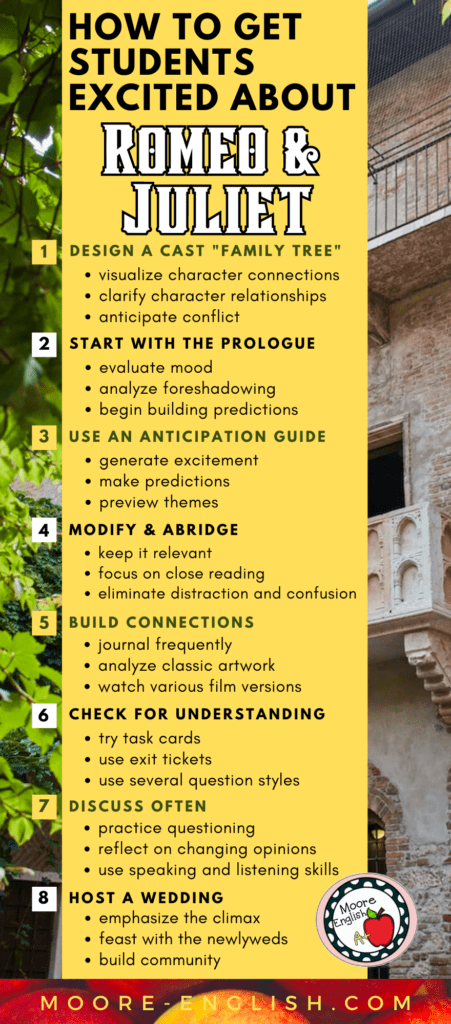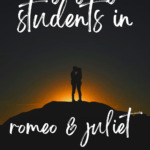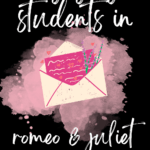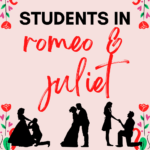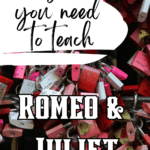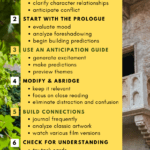Romeo and Juliet is a staple in countless classrooms. For my students, this is a centerpiece in the freshmen curriculum. However, students often find Romeo and Juliet boring, confusing, or irrelevant. For this reason, I have spent ages figuring out the best lesson plans and strategies to keep students engaged. Elevate your Shakespeare unit with these ideas and inspiration!
This post this post may contain affiliate links. Please read the Terms of Use.
Getting Started with Romeo and Juliet
Anticipation guides are one of my favorite ways to begin a new unit. Romeo and Juliet is no exception to this rule. When I use an anticipation guide, I give students 3-5 minutes to fill out the guide individually. Then, students discuss the first row of the anticipation guide, rotating every 2 minutes to discuss the next row with a new partner. Throughout the unit, we may revisit the anticipation guide to see how the big ideas continue to surface. Grab my free Romeo and Juliet anticipation guide.
Additionally, the Prologue is such a famous part of Romeo and Juliet that I always want to introduce it early on. This is also the strategy I use to establish my expectations for reading and annotating the play. I am such a strong believer in acting out plays as a class that I have already written an entire post about it. You can grab my free Prologue worksheet today!
Building Connections
Students often perceive Shakespeare as out of touch or irrelevant. To help students see the continued relevance of his works, I encourage students to write about the play. Using these 17 journal prompts, I encourage students to connect Romeo and Juliet to the real world, to current events, and to their own lives. I love using journals as bell work, conversation starters, and exit tickets.
Task cards are also a good option for bell work and exit tickets. I appreciate the flexibility of task cards because I can easily differentiate between tasks. Task cards are also a good way to build classroom community and to incorporate meaningful classroom movement. Grab my Romeo and Juliet task cards.
Similarly, I also want students to practice making text-text connections while we read the play. For this reason, I recently added the poem “Purgatory” by Maxine Kumin to my Romeo and Juliet unit. This is a perfect poem to study at the end of the play. It’s short, clever, and funny, so students love it, and it helps us practice synthesis thinking. Read it here.
Visualizing the Play
Visualizing is one of my favorite strategies to help students connect with and appreciate a text. At times, it seems daunting to compile high-quality visual resources, so I’ve taken the time to gather all my resources here in one place.
First, the cast of characters in Romeo and Juliet can be confusing for students. For this reason, I love this character map to help students see the relationships between and among characters. In particular, students sometimes struggle to remember who is loyal to the Capulets and who is loyal to the Montagues. In addition to the character map, I also help students remember that Capulet loyalists end with -t (like Tybalt), and Montague loyalists end in -o (like Benvolio).
CCSS.R.7 is one of the most challenging standards. It’s tough to gather the appropriate resources, so I have put them all together in one place. Overall, I have gathered 30 different images related to Romeo and Juliet. Throughout the play, we consider different images and evaluate how the artists and Shakespeare achieve similar meanings with different tools. Check it out here.
Of course, movie versions are a good way to help students visualize the play. Here are some of my favorite options:
- 1968: Franco Zeffirelli’s film is a classic for a reason. This is probably the most conservative option on the list, but sometimes my students appreciate it because it matches their mental version of the play.
- 1996: Leonardo DiCaprio and Claire Danes are often the favorite English teacher film choice. This is such a vivid film, and you can feel Baz Luhrmann in every scene. I also love the soundtrack!
- 2013: Hailee Steinfeld as Juliet is a great casting choice. The opening scene of this film is so different from the others on this list. Its high action easily engages students, and the casting of Benvolio is not what I would have expected, so it’s another good option.
- Crash Course Literature: While technically not a film version, these two videos are a good way to introduce additional interpretations of the text.
Planning for Romeo and Juliet
When you’re starting a text as long as Romeo and Juliet, there’s so much planning involved. As a new teacher, I always struggled with long-term plans, so I wanted to share this free unit planner and pacing guide.
When I start planning any unit, I always begin with the ending in mind. For this reason, I start with my unit assessment. You can check out my assessment here.
Additionally, in a unit like this, teachers also have to decide which version of the text they want to use. Our textbooks have a copy of the play, but it’s not accessible. It’s lacks meaningful footnotes and activities, so I skip it. I hope your textbook has a better option. No Fear Shakespeare is always a popular option, but since SparkNotes but up their pay wall, I have been disenchanted. For this reason, I have abridged all five acts with side-by-side questions and activities.

